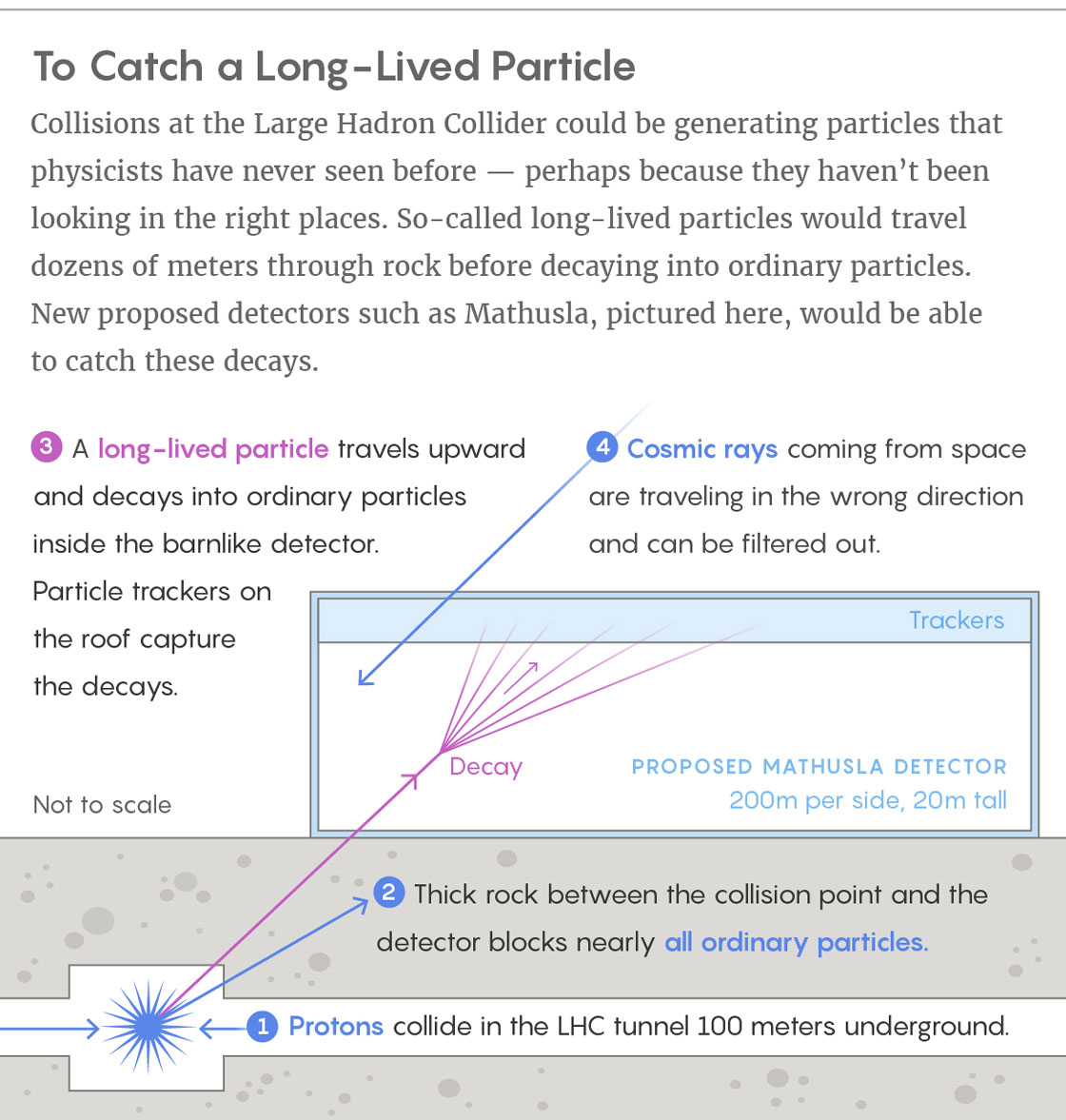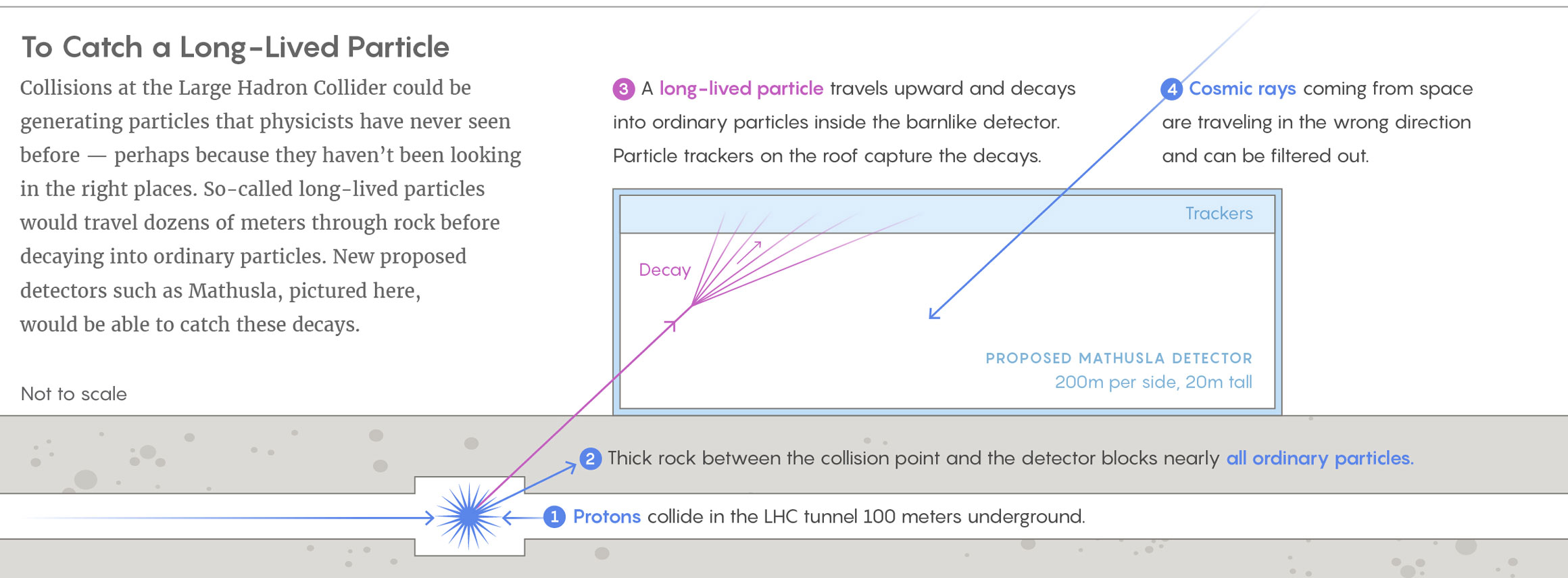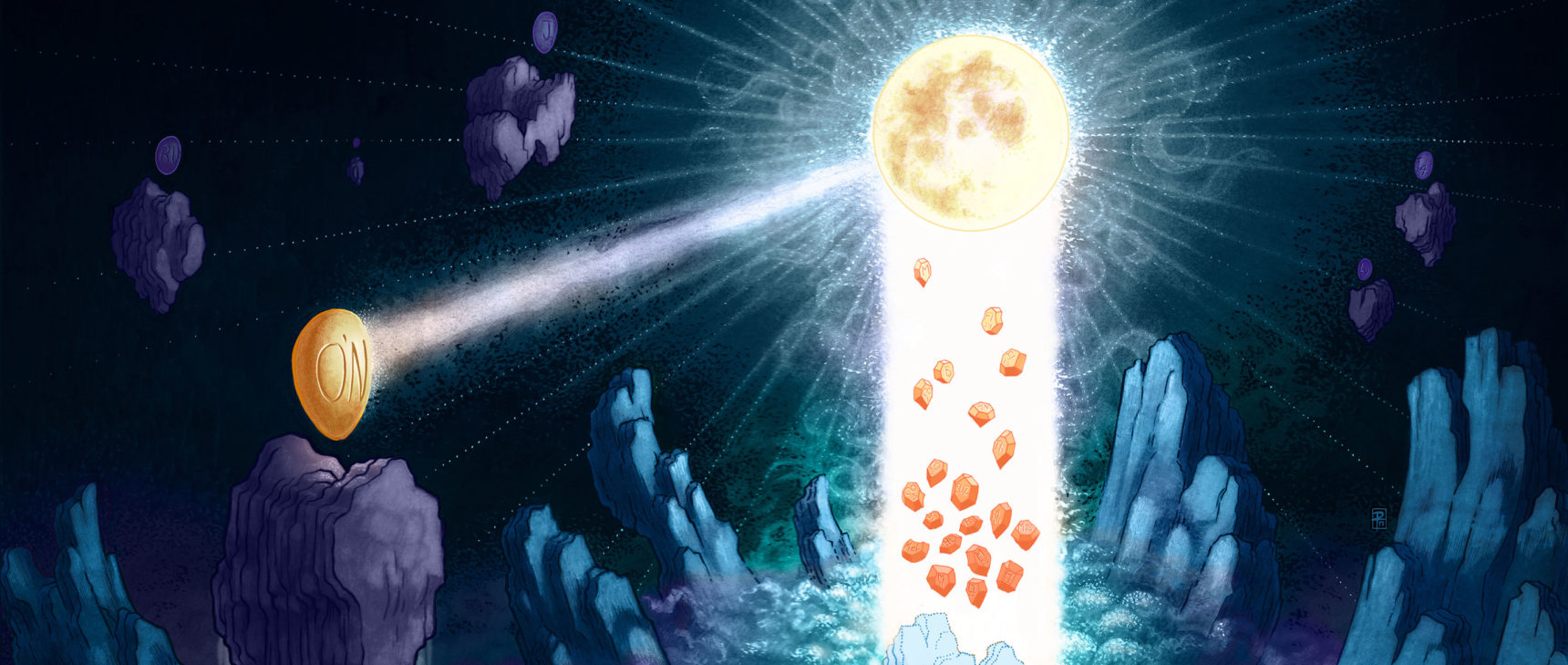How the Hidden Higgs Could Reveal Our Universe’s Dark Sector

Hypothetical “dark” Higgs bosons could travel hundreds of meters before decaying into ordinary particles.
Olena Shmahalo/Quanta Magazine
Introduction
The world’s most powerful particle accelerator, the Large Hadron Collider (LHC) at the CERN laboratory near Geneva, has failed to find any of the hoped-for particles that would lead physicists beyond the Standard Model of particle physics. But it’s possible that the LHC has been producing such pivotal new particles all along, and that we’re just not seeing them.
“The core of the story,” said David Curtin, a physicist at the University of Maryland, “is that the LHC could be making particles which are totally invisible, which decay some distance away from the production point, whether it’s millimeters or many kilometers, and which are connected at the most fundamental level to some of the most important theoretical mysteries that we have.”
Such hypothetical particles are called “long-lived,” because their lifetimes would far exceed those that the LHC was designed to detect. If the LHC is indeed producing these particles, then it’s likely that some are fleeing the accelerator’s underground tunnel, shooting up through the earth, and potentially exploding like fireworks in the sky above the nearby farm fields as they decay back into ordinary matter.
To catch the flash of those fireworks, assuming they exist, Curtin and collaborators Henry Lubatti of the University of Washington and John Paul Chou of Rutgers University have proposed building an enormous new detector that would stand in those fields, looking rather like a really big barn. The three recently published their proposal in Physics Letters B, christening their detector Mathusla (which, in the grand tradition of tortured physics acronyms, stands for MAssive Timing Hodoscope for Ultra Stable neutraL pArticles). The name is a nod to the mythical figure who lived for over 900 years.
“I think an experiment like that is really an expression of our times,” said Gian Giudice, who heads the theory department at CERN. For many years there has been “a sense of conviction about the right direction for exploration,” he said, with the field led by efforts to find short-lived particles predicted by a theory called supersymmetry. Yet those particles haven’t shown up as planned. “Now we are looking for new directions and new motivations, and that is what is really changing.”
Unfortunately, long-lived particles are difficult to detect. The good news is that our best hope for seeing them might stem from the one new particle the LHC has discovered and continues to produce: the Higgs boson.
Higgs Twins
The discovery of the Higgs in 2012 gave physicists two things at once: the triumph of finding the last missing piece of the Standard Model, but also compelling evidence that that same model is missing something essential.
The problem in the Standard Model lies in the fact that the measured mass of the Higgs is about 100 million billion times smaller than what quantum mechanics suggests it should be. From the standpoint of the Standard Model, this can be true only as a result of an extremely unlikely coincidence involving the values of some of the universe’s fundamental building blocks. (The coincidence is also exceptionally fortunate, because without it, atoms and everything they’re made of couldn’t exist.) Physicists call this situation the “hierarchy problem” and see it as evidence that the Standard Model is only an approximation of a more comprehensive theory that would explain the Higgs mass “naturally” — as the result of some mechanism other than an apparent miracle.
Supersymmetry has long been the leading candidate for the more comprehensive theory. It solves the hierarchy problem by means of new particles — one partner particle for each particle in the Standard Model. But with no sign of superpartners emerging from the LHC, some physicists are seriously considering the possibility that particles addressing the hierarchy problem belong to what’s called a hidden sector.
A hidden sector is a family of particles that may interact with each other but which don’t feel the effects of the Standard Model’s three forces — strong, electromagnetic and weak. They don’t directly interact with ordinary matter, which makes them very difficult to detect. But a hidden sector of particles could help solve the hierarchy problem, said Zackaria Chacko, a physicist at the University of Maryland who was one of the first to propose this idea in the early 2000s. “Naively, the way you can think about it is, the Standard Model particles want to pull their Higgs up and make the Higgs heavy,” he said. “And you have this hidden sector that is pulling it back down.”
Chacko’s model is called “Twin Higgs,” since the Higgs, like all the other Standard Model particles, would have a twin living in the hidden sector. The Higgs would play a special role by virtue of its ability to leave the Standard Model sector — in other words, the world in which we live — and pass into the hidden one by turning into its twin.
Is this really happening? The LHC’s proton-proton collisions create hundreds of Higgs bosons per hour, but they’re a tiny minority of the riot of particles continuously spraying out from those crashes and storming the accelerator’s detectors. Only a fraction of them can be counted. Based on the data collected so far, as many as a quarter of the LHC’s Higgs bosons could be slipping into the shadows of a hidden sector.
Tracking down such fugitives would be practically hopeless if not for a discovery made in 2014 by a team including Raman Sundrum, Chacko’s colleague at Maryland. Having reached what Sundrum describes as a “certain level of desperation” about the lack of new discoveries at the LHC, he and his collaborators gave Chacko’s model a second look and realized that it was just one of a whole class of theories that could restore naturalness by virtue of hidden particles. They also found that in the general case, some of the hidden particles that the Higgs decays into don’t stay hidden. Instead, they themselves decay — after a fraction of a second, which is still a Methuselah-like lifetime by subatomic standards — back into Standard Model particles. Such particles could be spotted at the LHC, or near it.
“There could be a lot of these things flying out all the time, and we just don’t know it,” said Christopher Hill, a physicist at Ohio State University and a senior member of CMS, one of the two teams that found the Higgs (ATLAS was the other). Hill, in collaboration with Andy Haas, a physicist at New York University who works on ATLAS, is behind a different proposal to find hidden-sector particles, called milliQan. The experiment’s name alludes to Robert Millikan, who was the first to measure the electron’s charge, but also highlights the fact that it is seeking particles with charges as small as one-thousandth of Millikan’s measurement, making them “millicharged.”
“We were going after a different portal with milliQan,” Hill said. Through this portal, an ordinary photon could transform into “dark” photons in a hidden sector. In that case, an electron-like particle in the hidden sector would appear as a millicharged one in the Standard Model sector.
Hidden sectors and portals may sound suspiciously like science fiction, devised by physicists driven to the sort of desperation Sundrum confessed to, but we already know of at least one instance where nature has played this game. Dark matter, no matter how little we know about it, presents strong evidence that another sector exists beyond the Standard Model.
In fact, physicists have invoked long-lived particles and hidden sectors to address virtually all the fundamental problems currently plaguing physics, including issues such as dark matter and the matter-antimatter asymmetry of the universe. “The idea of looking for hidden sectors is so natural, and so well-motivated, and so interesting, that you should just start with that,” said Nima Arkani-Hamed, a physicist at the Institute for Advanced Study in Princeton, New Jersey.
But looking for hidden sectors means smoking out those elusive long-lived particles.
Fireworks in the Barn
“Long lifetimes — you guys, this is insane!” Curtin recalls announcing at a workshop last year. “There’s nothing you can do; you can’t deflect it, you can’t trap it, you can’t make it scatter. It will just go off, and it will decay whenever the hell it wants. And you have to be right there when it decays.”
Curtin asked his audience for help.
Lubatti and Chou, experimentalists who were already engaged in searches for long-lived particles at ATLAS and CMS respectively — an endeavor Lubatti compares to “looking for a needle in a haystack, and we’re not even sure which haystack” — were both present at the workshop. The ensuing discussion ultimately resulted in the Mathusla collaboration. After months of meetings, Skype calls and simulations, the three worked out a preliminary design: a 20-meter-tall building that would cover an area larger than seven football fields. Five layers of particle trackers would hang from the ceiling, allowing researchers to reconstruct the subatomic debris of particle decays that happen in the massive space. The structure would be built on the ground above either the ATLAS or the CMS detector, where roughly 100 meters of dirt and rock would function to shield it from the continuous chaos of particle collisions down below, which could all too easily conceal a long-lived particle’s fireworks.


Lucy Reading-Ikkanda/Quanta Magazine
MilliQan is a smaller experiment that will require more finesse. Its detector would be wedged into the spare space of a cavelike tunnel left over from the LHC’s construction. Its challenge is that a particle having one-thousandth of an electron’s charge kicks out a mere millionth of the photons in a particle detector that an electron would. MilliQan therefore configures its detectors in three stacked tubes, each of them 1 meter long and all pointed at the spot where protons collide. The long tubes should be enough, Hill said, for a millicharged particle to kick one photon into each of the three layers, creating an unambiguous signal that should let physicists distinguish an actual millicharged particle from the stormy sea of background noise.
Although neither experiment has been approved by CERN, prototypes are already being built on the LHC’s grounds. Mathusla’s is a box 2.5 meters square and about 5.5 meters tall, cobbled together in part from materials scrounged from a cosmic-ray experiment in Tibet. MilliQan’s prototype is likewise a miniature version of the real thing, also built from scavenged parts, and benefiting from the kindness of the CMS team, who own the space it’s taking up.
“As with most long-lived particle searches … we’re like parasites living off the real physics that’s going on,” said Haas.
Compared to ATLAS and CMS, each of which employs thousands of people and uses super sophisticated detectors costing over half a billion dollars each, milliQan and Mathusla are decidedly humble proposals, the former feasible for maybe $1 million, the latter for a few tens of millions, and both based largely on particle detection technology that dates back to the Manhattan Project. It seems ridiculous to suggest that they could sniff out something the big dogs have missed.
And will they even get the chance?
“Scientifically, I think the case will be easy to make,” said Giudice, who sits on the committee at CERN that will decide both experiments’ fates. “Eventually the issue will be determined by practical aspects like cost, space and the time for the experiments to be ready.” If all goes well, the experiments will start collecting data after a planned major upgrade of the LHC in the mid 2020s.
The proposals benefit from a newfound sense of humility among particle physicists. As Arkani-Hamed put it, many “grand theoretical reasons” put forward to motivate searches for new physics over the past 40 years have “amounted to diddly squat so far.”
Now, Giudice said, “we need to look in all possible directions.”
It’s “just crazy,” Arkani-Hamed added, that the portals Mathusla and milliQan could probe are so “astonishingly big” and have yet to be explored. “It just tells you how little we actually know about what’s out there in the universe.”
This article was reprinted on Wired.com and Spektrum.de.



